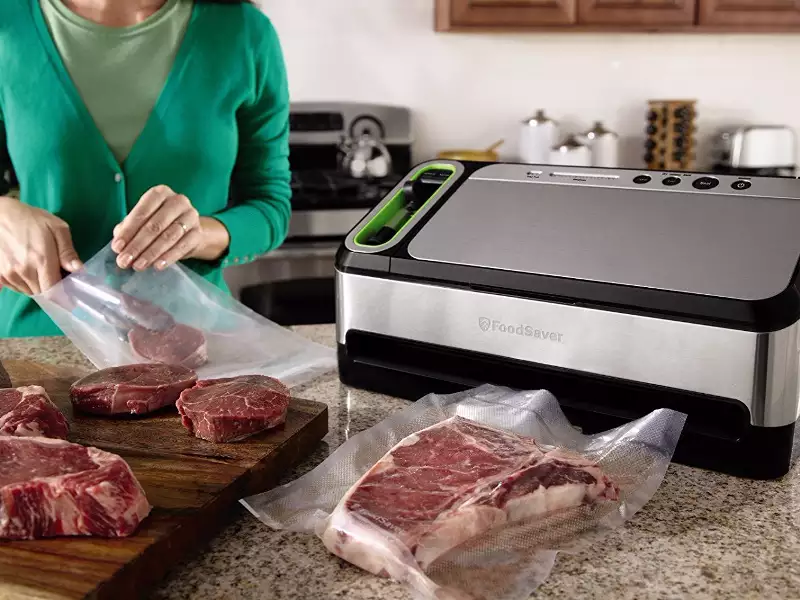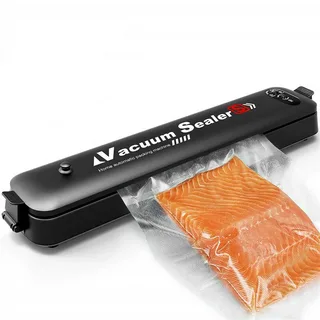Maximize Food Freshness: Vacuum Bag Sealer Machine Tips and Tricks In today’s bustling world, managing food waste and keeping your groceries fresh for longer can feel like a Herculean task. Fortunately, the humble vacuum-bag sealer machine has emerged as a knight in shining armor for households and culinary aficionados alike. By extracting air and sealing flavor, this nifty gadget not only prolongs the shelf life of your edibles but also helps in marinating meats more efficiently and reducing freezer burn. If you’re keen on leveraging this technology to its fullest, join us as we delve into a comprehensive guide brimming with tips and tricks.
Understanding the Basics of Vacuum-Sealing Technology
Vacuum-sealing technology operates on a straightforward yet powerful concept: the elimination of air from a bag or container to prevent the proliferation of microorganisms such as bacteria, mound, and yeast. These microorganisms are primarily responsible for the degradation of food, leading to spoilage. By creating an environment with significantly reduced oxygen levels, vacuum-sealing effectively extends the lifespan of a wide array of foodstuffs.
This method is particularly beneficial for preserving the original taste, texture, and nutritional value of foods for longer periods. It is suitable for a diverse range of items, including vegetables, cheeses, meats, and even liquids. The essence of this technology lies in its ability to maintain food quality by minimizing the factors that typically hasten spoilage. As such, understanding the core principles behind vacuum sealing is the first step in utilizing this innovative method to its full potential, ensuring your food remains fresh and appetizing for as long as possible.
Selecting the Right Type of Bags and Containers
When it comes to vacuum sealing, not every bag or container will meet your preservation needs efficiently. It’s essential to choose bags and containers that are tailor-made for vacuum sealing, as these are crafted to ensure the most effective air removal and seal formation. Look for bags that are slightly thicker than your average plastic bag; these often feature a textured or embossed pattern, which is crucial for allowing the vacuum sealer to perform optimally by facilitating the removal of air. For those concerned about environmental impact, there are reusable options on the market.
These sustainable choices can be washed and used multiple times, provided they are meticulously cleaned and dried to prevent bacterial growth and maintain hygiene. It’s important, however, to verify that any reusable bag or container is compatible with your specific vacuum sealer model to avoid any functionality issues. Moreover, when opting for containers, ensure they come with a valve or an attachment port that can be connected to your vacuum sealer, as this will enable efficient air extraction. Selecting the appropriate bags and containers is not just about compatibility; it’s about ensuring the longevity and freshness of your food by utilizing the best materials for the job.
Maximizing Seal Integrity with Vacuum and Seal Machine
To ensure that your food preservation efforts are not in vain, achieving a robust, hermetic seal is imperative. A vital step in this process is to allow a generous margin above the foodstuff in the bag; this space is essential to prevent any food particles from encroaching on the seal zone, potentially compromising its integrity. A practical approach to bolster the seal is to double-seal the bag, providing an additional layer of protection. Another key factor to consider is the condition of the sealing area.
It must be devoid of any moisture, as dampness can significantly weaken the seal, making it less effective. Regular upkeep of your vacuum and seal-machine, in alignment with the guidance provided by the manufacturer, plays a crucial role in maintaining its efficiency. This routine maintenance not only ensures that the vacuum and seal machine functions at its optimal capacity but also aids in prolonging its lifespan. By adhering to these recommendations, you can enhance the seal integrity of your vacuum-sealed packages, thereby extending the freshness and shelf life of your foods.
Pre-Freezing Foods with High Moisture Content
When dealing with high-moisture foods such as fresh fruit, raw meat, and certain vegetables, a direct approach to vacuum sealing may not always yield the best results. The presence of excess liquid can pose challenges, potentially leading to a messy sealing process and even risking damage to your vacuum sealer. To circumvent these issues, a practical solution lies in pre-freezing these items. By spreading the food on a baking tray and placing it in the freezer for a few hours, you effectively solidify the moisture content.
This preliminary step not only facilitates a smoother sealing process but also preserves the natural texture and quality of the food. It’s a simple yet effective technique to ensure that your vacuum-sealed packages are free from unwanted liquid spillage and are perfectly prepped for long-term storage. Moreover, this method significantly reduces the likelihood of liquids being drawn into the vacuum sealer, thereby safeguarding the machine’s functionality and extending its service life. Adopting this pre-freezing strategy can enhance your vacuum-sealing practices, especially when preserving foods that are inherently rich in moisture.
Labelling Your Vacuum-Sealed Packages
An often-overlooked yet vital aspect of efficient vacuum-sealing practices involves the meticulous labelling of your vacuum-sealed packages. Proper labelling not only aids in organizing your food storage but also plays a crucial role in ensuring food safety and maximizing the utility of your preserved goods. Start by including the name of the food item along with the date it was sealed on each package.
This simple step allows for easy identification and helps in monitoring the shelf life of various foods, ensuring that none go to waste due to oversight or confusion. Utilizing a permanent marker is a straightforward and effective method for marking bags directly. However, for those preferring a more reusable and environmentally friendly approach, consider attaching labels that can be removed and replaced as necessary. This method is especially useful for containers that are reused for vacuum sealing. It’s also beneficial to note any specific preparation or cooking instructions alongside the basic information.
For instance, if you’ve vacuum-sealed a portion of marinated meat, jotting down the marinating ingredients and suggested cooking time can be incredibly handy when it comes time to prepare the meal. Similarly, for vegetables or fruits, indicating whether they have been pre-blitzed or require any specific preparation method before use can save time and ensure optimal use of your preserved produce.
 The Importance of Vacuum Heat Sealer Machine
The Importance of Vacuum Heat Sealer Machine
In the realm of vacuum sealing, the efficacy of a vacuum heat sealer machine cannot be overstated. These devices, equipped with heating elements, are fundamental for creating an airtight seal that is crucial for prolonging the freshness of food. Unlike manual alternatives, a heat-sealer machine applies consistent heat to the edges of the vacuum-seal bag, ensuring that the plastic layers fuse effectively. This process results in a seal that is remarkably resilient against air penetration, thereby significantly extending the shelf life of its contents. A key advantage of utilizing such a machine is its ability to handle a variety of bag thicknesses and types, providing versatility in food preservation tasks.
For individuals serious about reducing food wastage and enhancing the efficiency of their food storage practices, investing in a quality heat-sealer machine is a prudent decision. It not only streamlines the vacuum-sealing process but also ensures that foods retain their nutritional value, texture, and flavor for extended periods. This makes it an indispensable tool for anyone looking to optimize their kitchen operations, from avid home cooks to professional chefs. With proper use and maintenance, a heat-sealer machine can serve as a reliable companion in the quest for achieving optimal food preservation results.
Exploring Advanced Vacuum-Sealing Techniques
Delving deeper into the realm of vacuum sealing unveils a plethora of sophisticated techniques that can significantly enhance your food preservation and preparation practices. A particularly noteworthy method is the utilization of vacuum-sealed bags for marinating meat. This technique not only expedites the marinating process but also ensures that the flavors penetrate more deeply and evenly throughout the meat, resulting in a more succulent and aromatic dish. Furthermore, the strategic portioning of meals before vacuum sealing presents an ingenious solution for efficient meal preparation.
This approach not only facilitates a streamlined and organized kitchen but also offers a convenient and healthy dining option for those times when life gets exceptionally busy. experimenting with the vacuum sealing of delicate items by using a ‘pulse’ function, if your machine has one, allows for careful control of the vacuum process, preventing crushing or deformation.
This is particularly useful for softer fruits and bakery items, ensuring they maintain their shape and texture. For the adventurous home cook or the professional chef looking to push boundaries, integrating sous vide cooking with vacuum-sealed foods opens up a new dimension of culinary possibilities. Cooking vacuum-sealed ingredients in a precisely controlled water bath ensures even cooking and retains moisture, leading to dishes that are consistently tender and flavorful. By embracing these advanced vacuum-sealing techniques, you can unlock a new level of creativity and efficiency in your cooking and food preservation efforts.
FAQs
Q: Are there exceptions to the types of food that can be vacuum-sealed?
A: Indeed, whilst the majority of foodstuffs are suitable for vacuum sealing, certain items such as soft cheeses and some varieties of mushrooms may benefit from alternative preparation methods or should be pre-frozen to preserve their structure and prevent squashing under vacuum pressure.
Q: What is the typical longevity of vacuum-sealed goods in storage?
A: The durability of vacuum-sealed items can significantly surpass that of foods stored using traditional methods. Typically, vacuum sealing can extend a food’s life by 3 to 5 times. However, this can vary widely based on the food type, its initial freshness, and the storage conditions.
Q: Is it permissible to reuse vacuum-seal bags, and if so, how?
A: Many vacuum-seal bags are designed with reuse in mind, offering an eco-friendly storage option. To ensure safety and hygiene, it’s crucial to thoroughly clean and dry them before their next use. Pay special attention to removing any food residue and moisture to prevent the growth of bacteria and mound.
Q: Can vacuum-sealing affect the texture or taste of food?
A: Properly applied, vacuum sealing should not adversely affect the taste or texture of food. It can preserve these qualities for longer by reducing exposure to air, which can accelerate spoilage and degrade flavor and texture over time.
Conclusion
Embracing vacuum-seal technology offers an innovative pathway to reduce food waste, maintain nutritional value, and savor the original flavors of your meals for longer. Armed with the tips and tricks outlined in this guide, you’re well-equipped to enhance the efficacy of your food preservation efforts. Whether you’re a home cook or a culinary expert, the vacuum-bag sealer machine emerges as an indispensable ally in the kitchen, promising freshness and efficiency. By incorporating these practices, you pave the way for a more sustainable and flavorful food experience.
| Other Good Articles to Read |
| Skank Blogs |
| Unreal Blogs |
| Tba Blogs |
| All City Forums |
| Dany Blogs |
| Refuge Blogs |
| The Music Blogs |
| Key Forums |
| The Big Blog Theory |
| Joe Blogs |
| Blogs 4 Me |
| Blogs Emon |
| Related Business Listings |
| Contact Directory |
| Local Business Profiles |


